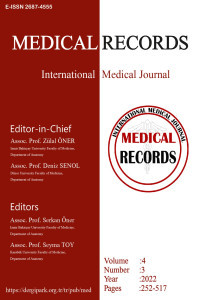Five-Years Intensive Care Percutaneous Tracheostomy Results
Five-Years Intensive Care Percutaneous Tracheostomy Results
Aim: Tracheostomy is an interventional procedure frequently performed on critically ill patients in the intensive care unit (ICU). The purpose of this study is to report the characteristics of patients undergoing percutaneous tracheostomy in intensive care.
Material and Methods: Cases admitted to intensive care between 2018 and 2022 and subjected to percutaneous tracheostomy were included. Cases involving surgical tracheostomy were excluded. We scanned the patients’ demographic and clinical characteristics, follow-up characteristics in intensive care, tracheostomy complications, and discharge characteristics. Patients were also divided into surviving and non-surviving groups and compared.
Results: One hundred seven patients were included in the study. Men represented 64.5% of the patients, and the mean age of the entire patient group was 61.5 years. Tracheostomies were most frequently performed due to prolonged endotracheal intubation. Neurological diseases were the most common diagnoses, and the most frequent complication was bleeding. The groups differed in terms of age, comorbidity, presence of tracheostomy at time of discharge from intensive care, and anticoagulant use. The mortality rate was 69.2%.
Conclusion: We think that percutaneous tracheostomy can be employed because it can be performed at the point of care in intensive care, and due its ease of application and low complication rate.
Keywords:
tracheostomy, percutaneous intensive care,
___
- Yesiller FI, Sendur UG. Our experiences of tracheostomy in intensive care unit. Aegean J Med Sci. 2018;2:1-5.
- Mehta C, Mehta Y. Percutaneous tracheostomy. Ann Card Anaesth. 2017;20:S19-25.
- Canakci E, Sahin EA, Kilic K. Percutaneous tracheostomy with Grigss dilating forceps technique: Retrospective analysis of 60 intensive care patients. Ege Journal of Medicine. 2016;55:184-9.
- Whited RE. A prospective study of laryngotracheal sequelae in long-term intubation. Laryngoscope. 1984;94:367-77.
- Ersoy A, Ali A, Unlu N, et al. 53 percutaneous tracheostomy cases performed with griggs method. Okmeydanı Med J. 2012;28:134-7.
- Friedman Y. Percutaneous versus surgical tracheostomy: the continuing saga. Crit Care Med. 2006;34:2250-1.
- Yeniaras E, Cebecik Teomete G, Karabag G et al. Percutan dilational tracheostomy; our experience. İstanbul Med J 2007;8:7-12.
- Griffiths J, Barber VS, Morgan L et al. Systematic review and meta-analysis of studies of the timing of tracheostomy in adult patients undergoing artificial ventilation. BMJ. 2005;330:1243.
- Bösel J, Niesen WD, Salih F et al.; SETPOINT2 and the IGNITE Study Groups. Effect of early vs standard approach to tracheostomy on functional outcome at 6 months among patients with severe stroke receiving mechanical ventilation: the SETPOINT2 randomized clinical trial. JAMA. 2022;327:1899-909.
- Andriolo BN, Andriolo RB, Saconato H, et al. Early versus late tracheostomy for critically ill patients. Cochrane Database Syst Rev. 2015;1:CD007271.
- Oncul S, Yilmaz M, Gaygusuz EA, et al. Our experience in percutaneous tracheostomy which performed by Griggs method: 38 cases. Kocaeli Med J. 2014;3:1-4.
- Fernandez-Bussy S, Mahajan B, Folch E et al. Tracheostomy tube placement: early and late complications. J Bronchology Interv Pulmonol. 2015;22:357-64.
- Cicek M, Gedik E, Yücel A et al. Our conclusions at percutaneous tracheostomy performed with griggs technique. İnönü Üniversitesi Tıp Fakültesi Dergisi. 2007;14:17-20.
- Yayın Aralığı: Yılda 3 Sayı
- Başlangıç: 2019
- Yayıncı: Zülal ÖNER
Sayıdaki Diğer Makaleler
Effects of Electromagnetic Field (1.8/0.9 GHz) Exposure on Spleen in Rats
İlker KIZILOĞLU, Yeliz YILMAZ BOZOK, Levent TÜMKAYA, Dilek AKAKIN, Dila ŞENER AKÇORA
Sezgin BİLGİN, Kerim ASLAN, Esra TURUNÇ, Burhan DOST, Hakan AYGÜN, Ersin KÖKSAL
COVID 19 Hastalarında Arcus Aorta Açısı ve Arcus Aorta Morfometrisi: Radyoanatomik bir Çalışma
Rukiye ÇİFTÇİ, Hilal ER ULUBABA, Sibel ATEŞOĞLU KARABAŞ
The Effect of Mesh Fixation Methods on Pain Sensation After Laparoscopic Inguinal Hernia Repair
Zekiye İpek KATIRCI KIRMACI, Suat EREL
Osman KULA, Ahmet Onur ÇELİK, Burak GÜNAY
İlteriş Ahmet ŞENTÜRK, Edip GÖNÜLLÜ
High Salt-Induced Hyperosmolality Reduces in Vitro Survival and Proliferation of Pre-B Cells
